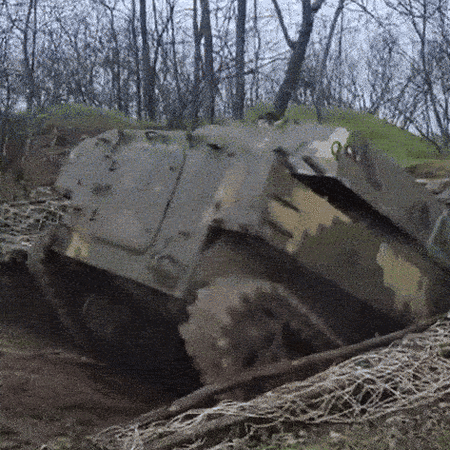In the ongoing Russia-Ukraine war, unprecedented tactics are being employed on the front lines. For instance, there are drones designed to be deliberately captured and unmanned boats capable of targeting enemy fighters. Additionally, some strategies from World War I, such as the use of optical illusions and double-barreled shotguns, have resurfaced. However, one of the most unusual tactics observed is the burying of a battle tank.
Buzz of drones. This story traces back several months. In the dense forests surrounding Toretsk, a burning city in Eastern Ukraine, the sounds of war changed dramatically in October. It was no longer just the thunder of artillery that characterized the battlefield. Instead, it was the constant buzz of drones racing through the skies in search of targets.
In Donetsk, soldiers of the 28th Separate Mechanized Brigade awaited orders with their modernized T-64 tanks, which have lost some of their former prominence. The era of the dominant tank has transitioned to a new phase. Cautious tanks are now compelled to adapt to warfare heavily influenced by electronic surveillance and miniature airstrikes.
The loss of invulnerability. The T-64 tank was once a symbol of invincible power. The roar of its engine instilled the illusion that nothing could harm its driver. However, that feeling has diminished, and what was once a strategic advantage has turned into a vulnerability.
Tanks, whether of Soviet design or modern American M1A1 Abrams, are being withdrawn from the front lines. This isn’t due to a lack of power, but because they’re increasingly susceptible to low-cost FPV drones. For just $500, these drones can destroy machines valued in the millions. Warfare has become an equation of technological asymmetry, where the small can defeat the colossal.
The invisible air war. Modern warfare isn’t only fought on the ground but also in the air. The extensive Ukrainian front line, stretching more than 680 miles, has seen the rise of swarms of small explosive drones. They tirelessly fly overhead, engaged in lethal surveillance and destruction. Each month, both Ukrainian and Russian forces deploy around two million FPV drones. These tiny, remotely guided machines are capable of carrying explosive charges powerful enough to destroy vehicles or take lives.
The size, speed, and maneuverability of these drones make them relentless hunters of both moving and stationary targets, particularly artillery pieces, tanks, and fortified positions. This aerial threat has fundamentally transformed frontline strategy, pushing combat from above ground to below ground. Cautious armor is the new standard in warfare.
 A Ukrainian tank emerging from the ground.
A Ukrainian tank emerging from the ground.
A new military strategy. Ukrainian artillery units have begun digging deep burrows to conceal not only their crews but also their large artillery pieces. Videos have surfaced showing a Ukrainian battery operating a 2S1 Gvozdika, an 18-ton self-propelled howitzer, positioned underground in a shelter constructed with heavy machinery.
The entrance to these positions is fortified with logs and a thick net designed to intercept enemy drones. These shelters are so deep that even the vehicle struggles to emerge when it needs to fire. Official photographs from the Ukrainian 36th Marine Regiment indicate that these underground positions aren’t isolated incidents. They’re part of a trend emerging along the front lines, particularly in vulnerable areas like the border with the Russian Kursk region.
Trench 2.0. The conflict evolution has reverted modern soldiers to a buried way of life, albeit enhanced by 21st-century technology. The constant aerial threat has necessitated a complete redesign of deployment and concealment tactics. In this context, visual camouflage is no longer enough. Layered earth, reinforced structures, and the logistical capability to securely bury heavy machinery have become essential.
According to Forbes, these vehicles must remain hidden underground, surfacing only briefly to carry out firing missions before retreating back under the protection of the earth. This strategic movement underscores a stealthy, methodical, and fundamentally defensive approach to combat. It starkly contrasts with the traditional dynamism associated with armored vehicle warfare.
Drones and tactical response. While FPV drones can be deadly, they’re not invulnerable. Radio-controlled drones can be neutralized through electronic jamming. Meanwhile, those guided by fiber-optic cables can reveal the operator’s position if the cable is traced. However, their proliferation has reached a level where the terrain no longer provides enough protection without substantial mechanical intervention.
Nets, shielding, traps, and improvised structures have proven inadequate against the constant vigilance of the thousands of flying drones. As a result, many Ukrainian units have turned to the ground for defense, which offers a truly effective means of protection. This shift explains why these units have initiated fundraising campaigns to acquire bulldozers. They recognize that their survival now relies not only on weaponry but also on access to civilian machinery capable of creating underground shelters.
Adaptation to urgency. What began as an improvised response to the rise in unmanned aerial attacks has evolved into a new tactical pattern. In a war saturated with technology, where visibility equates to vulnerability and mobility involves risk, concealment has become a viable strategy.
Artillery was once a symbol of power and visibility on the battlefield, but it’s now often hidden and treated as endangered loot. This unexpected, yet perhaps inevitable, twist in the conflict highlights how AI, technological miniaturization, and asymmetric warfare have pushed humans and their machinery underground in search of a way to endure.
Image | Scott
Related | Ukraine Is Sending Drones to Russia That, When Captured, Infect Military Systems With Malware



